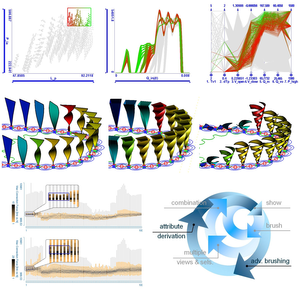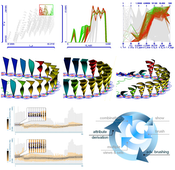Information
- Publication Type: PhD-Thesis
- Workgroup(s)/Project(s):
- Date: January 2013
- Date (Start): 2006
- Date (End): 2013
- Second Supervisor: Helwig Hauser
- 1st Reviewer: Eduard Gröller
- 2nd Reviewer: Helwig Hauser
- Rigorosum: 1. February 2013
- First Supervisor: Eduard Gröller
Abstract
Computational simulation has become instrumental in the design process in automotive engineering. Virtually all components and subsystems of automobiles can be simulated. The simulation can be repeated many times with varied parameter settings, thereby simulating many possible design choices. Each simulation run can produce a complex, multivariate, and usually timedependent result data set. The engineers’ goal is to generate useful knowledge from those data. They need to understand the system’s behavior, find correlations in the results, conclude how results depend on the parameters, find optimal parameter combinations, and exclude the ones that lead to undesired results.Computational analysis methods are widely used and necessary to analyze simulation data sets, but they are not always sufficient. They typically require that problems and interesting data features can be precisely defined from the beginning. The results of automated analysis of complex problems may be difficult to interpret. Exploring trends, patterns, relations, and dependencies in time-dependent data through statistical aggregates is not always intuitive.
In this thesis, we propose techniques and methods for the interactive visual analysis (IVA) of simulation data sets. Compared to computational methods, IVA offers new and different analysis opportunities. Visual analysis utilizes human cognition and creativity, and can also incorporate the experts’ domain knowledge. Therefore, their insight into the data can be amplified, and also less precisely defined problems can be solved.
We introduce a data model that effectively represents the multi-run, time-dependent simulation results as families of function graphs. This concept is central to the thesis, and many of the innovations in this thesis are closely related to it.We present visualization techniques for families of function graphs. Those visualizations, as well as well-known information visualization plots, are integrated into a coordinated multiple views framework. All views provide focus+context visualization. Compositions of brushes spanning several views can be defined iteratively to select interesting features and promote information drill-down. Valuable insight into the spatial aspect of the data can be gained from (generally domain-specific) spatio-temporal visualizations. In this thesis, we propose interactive, glyph-based 3D visualization techniques for the analysis of rigid and elastic multibody system simulations.
We integrate the on-demand computation of derived data attributes of families of function graphs into the analysis workflow. This facilitates the selection of deeply hidden data features that cannot be specified by combinations of simple brushes on the original data attributes. The combination of these building blocks supports interactive knowledge discovery. The analyst can build a mental model of the system; explore also unexpected features and relations; and generate, verify or reject hypotheses with visual tools; thereby gaining more insight into the data. Complex tasks, such as parameter sensitivity analysis and optimization can be solved. Although the primary motivation for our work was the analysis of simulation data sets in automotive engineering, we learned that this data model and the analysis procedures we identified are also applicable to several other problem domains. We discuss common tasks in the analysis of data containing families of function graphs.
Two case studies demonstrate that the proposed approach is indeed applicable to the analysis of simulation data sets in automotive engineering. Some of the contributions of this thesis have been integrated into a commercially distributed software suite for engineers. This suggests that their impact can extend beyond the visualization research community.
Additional Files and Images
Weblinks
No further information available.BibTeX
@phdthesis{Konyha_2013_IVA,
title = "Interactive Visual Analysis in Automotive Engineering Design",
author = "Zoltan Konyha",
year = "2013",
abstract = "Computational simulation has become instrumental in the
design process in automotive engineering. Virtually all
components and subsystems of automobiles can be simulated.
The simulation can be repeated many times with varied
parameter settings, thereby simulating many possible design
choices. Each simulation run can produce a complex,
multivariate, and usually timedependent result data set. The
engineers’ goal is to generate useful knowledge from those
data. They need to understand the system’s behavior, find
correlations in the results, conclude how results depend on
the parameters, find optimal parameter combinations, and
exclude the ones that lead to undesired results.
Computational analysis methods are widely used and necessary
to analyze simulation data sets, but they are not always
sufficient. They typically require that problems and
interesting data features can be precisely defined from the
beginning. The results of automated analysis of complex
problems may be difficult to interpret. Exploring trends,
patterns, relations, and dependencies in time-dependent data
through statistical aggregates is not always intuitive. In
this thesis, we propose techniques and methods for the
interactive visual analysis (IVA) of simulation data sets.
Compared to computational methods, IVA offers new and
different analysis opportunities. Visual analysis utilizes
human cognition and creativity, and can also incorporate the
experts’ domain knowledge. Therefore, their insight into
the data can be amplified, and also less precisely defined
problems can be solved. We introduce a data model that
effectively represents the multi-run, time-dependent
simulation results as families of function graphs. This
concept is central to the thesis, and many of the
innovations in this thesis are closely related to it.We
present visualization techniques for families of function
graphs. Those visualizations, as well as well-known
information visualization plots, are integrated into a
coordinated multiple views framework. All views provide
focus+context visualization. Compositions of brushes
spanning several views can be defined iteratively to select
interesting features and promote information drill-down.
Valuable insight into the spatial aspect of the data can be
gained from (generally domain-specific) spatio-temporal
visualizations. In this thesis, we propose interactive,
glyph-based 3D visualization techniques for the analysis of
rigid and elastic multibody system simulations. We
integrate the on-demand computation of derived data
attributes of families of function graphs into the analysis
workflow. This facilitates the selection of deeply hidden
data features that cannot be specified by combinations of
simple brushes on the original data attributes. The
combination of these building blocks supports interactive
knowledge discovery. The analyst can build a mental model of
the system; explore also unexpected features and relations;
and generate, verify or reject hypotheses with visual tools;
thereby gaining more insight into the data. Complex tasks,
such as parameter sensitivity analysis and optimization can
be solved. Although the primary motivation for our work was
the analysis of simulation data sets in automotive
engineering, we learned that this data model and the
analysis procedures we identified are also applicable to
several other problem domains. We discuss common tasks in
the analysis of data containing families of function graphs.
Two case studies demonstrate that the proposed approach is
indeed applicable to the analysis of simulation data sets in
automotive engineering. Some of the contributions of this
thesis have been integrated into a commercially distributed
software suite for engineers. This suggests that their
impact can extend beyond the visualization research
community.",
month = jan,
address = "Favoritenstrasse 9-11/E193-02, A-1040 Vienna, Austria",
school = "Institute of Computer Graphics and Algorithms, Vienna
University of Technology ",
URL = "https://www.cg.tuwien.ac.at/research/publications/2013/Konyha_2013_IVA/",
}


 Image
Image Thesis
Thesis
